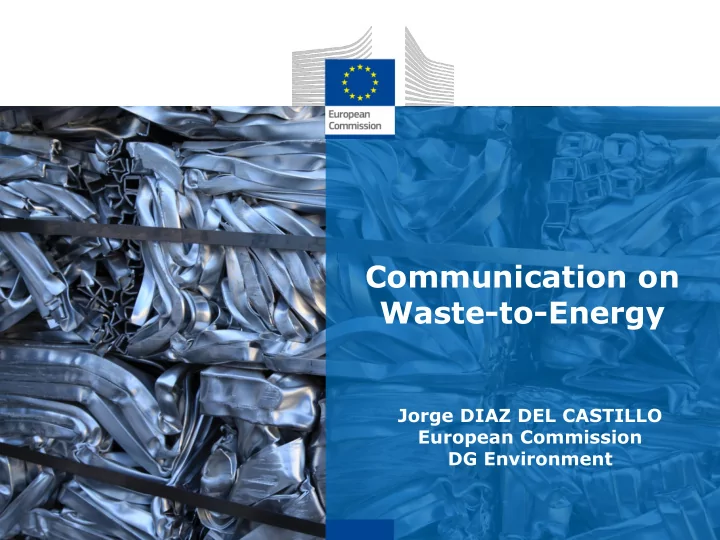

Communication on Waste-to-Energy Jorge DIAZ DEL CASTILLO European Commission DG Environment
Fact #1 W2E is the bridge between Circular Economy and the Energy Union 2
Fact #2 Approximately 1.5 % of the EU’s total final energy consumption comes from waste 3
Fact #3 W2E covers more than waste incineration 4
Fact #4 ….but, they are not all the same 5
Fact #5 …and they are not incinerating the 50 same amount of municipal waste 50 56 54 18 9 27 48 15 44 35 35 19 12 35 38 10 2 21 Dark Red: >40% 21 2 12 Red: 30%-40% Orange: 10%-30% Green: <10% Blue: 0% Source: EUROSTAT, 2015 Cyprus & Malta
Fact #6 Feedstock for W2E forecast Mixed waste: waste prevention, widespread separate collection and ambitious recycling targets could potentially lead to less feedstock available for W2E Wood, plastic, textile, tyre, solvents, etc : energy recovery could see a reduced role in future, primarily due to the better application of the waste hierarchy Biodegradable waste : energy recovery through anaerobic digestion should increase
Fact #7 "Getting more energy from less waste" • Co-incineration of syngas from SRF • Conversion of waste heat to power in cement kilns • Raising the temperature in dedicated incinerators (super heaters, heat pumps) • Turning biogas from anaerobic digestion into bio-methane …but also fostering the use of CHP and facilitating the use of heating (and cooling) district networks and symbiosis in industrial parks 8
Message #1 Public support for W2E should be aligned with the waste hierarchy 9
Message #2 MS with low or non-existent incineration: • Careful and forward-looking planning • Considering available W2E capacity 10
Message #3 MS with high incineration: • Use of economic instruments (e.g. taxes) • Rearranging existing support schemes • Moratorium & decommissioning 11
Message #4 …and if incineration is absolutely needed: • Suitable location • Optimal capacity • Proven state-of-the-art energy-efficient technology 12
Message #5 The Commission will remain committed to: assessing waste management plans to ensure that MS give priority to separate collection and recycling where prevention or re-use is not achievable ensuring that EU funding and other public financial support is directed towards waste treatment options that are in line with the waste hierarchy promoting W2E processes with high energy (and material) yields 13
http://ec.europa.eu/environment/
Recommend
More recommend